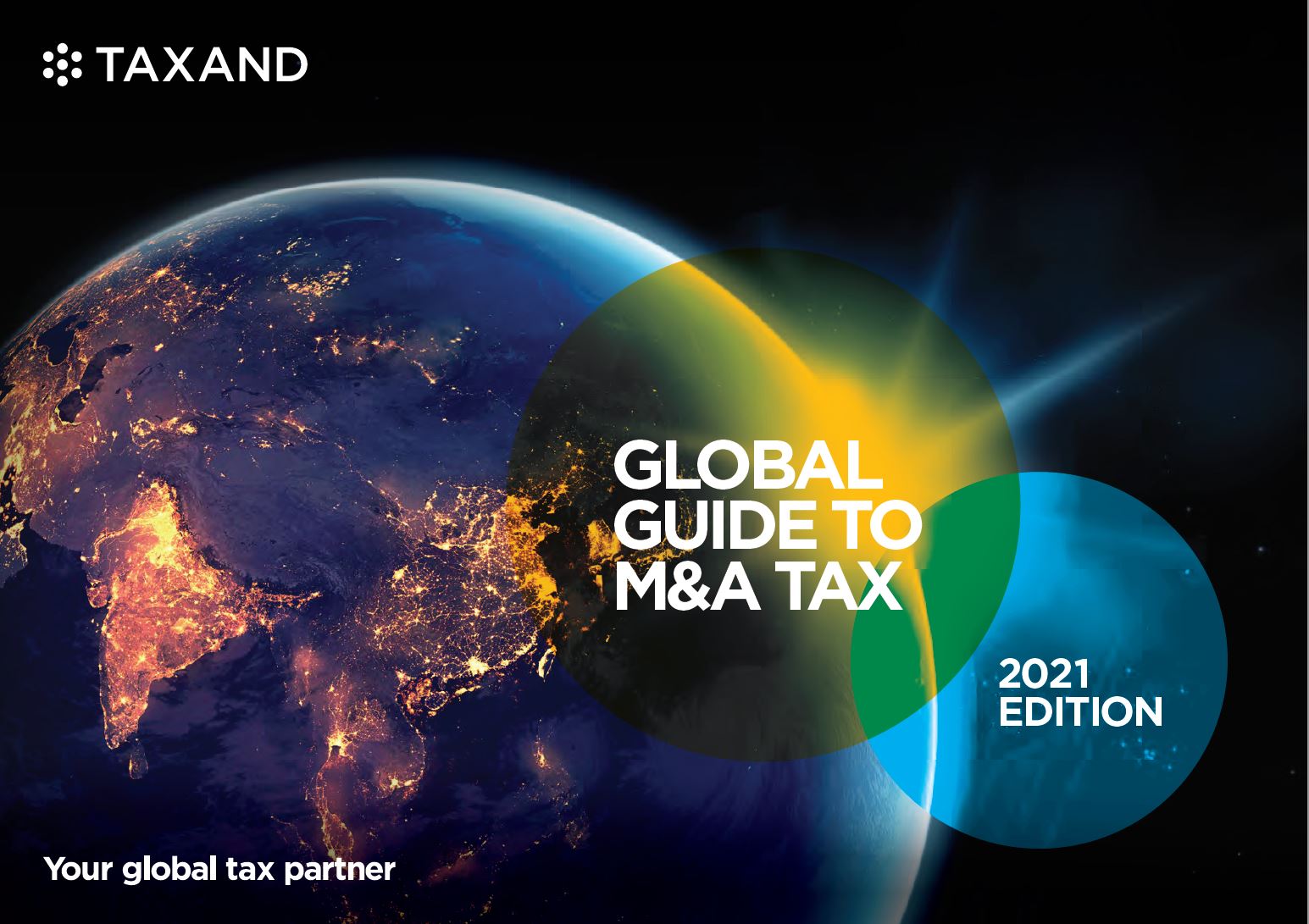Taxand 2021 Global Guide to M&A Tax

|
Update as of July 2021:
Commenting on the guide, James Stanley, Alvarez and Marsal Managing Director, and Head of the Taxand M&A Tax Service Line said: The release of the Global Guide could not have come at a better time. The first half of 2021 has turned out to be record-breaking, with more deal volume and announcements than any other H1 on record. What has spurred the flurry of activity? There are several factors contributing to making the first six months of 2021 the most robust on record for deals: historically low-interest rates; pent up deal demand from a global pandemic lockdown; PE dry powder in excess of $1.6 trillion (and corporate cash at record levels); US elections being out of the way; taking advantage of post-pandemic opportunistic plays in areas such as technology, media, and health-care; and accelerating deal activity due to the Biden administration’s tax-raising goals.
The Global Guide is a resource to help those involved in the deal process become “smarter” in short order in the areas of tax diligence, structuring, and integration – including request lists and treaty tables by country. Finally, it contains the latest updates around COVID and local country tax legislation.
If one word could be used to describe 2020, it would be “resilience.” During the course of last year, the global pandemic – COVID-19 – and global responses to it brought the global economy to its knees while slowing deal activity to a crawl during the second quarter. 2020 also provided the backdrop for one of the most tumultuous US election seasons in over 100 years, leaving global markets with a level of uncertainty not seen since the financial crisis. The past year also left the markets wondering whether a trade deal would ever be struck between the UK and the European Commission as the Brexit deadline loomed. US bankruptcy filings in 2020 by companies with more than $50 million of liabilities totaled greater than 225 as of the end of November, the most such filings on a comparable period basis since 2009, according to Bloomberg data. As if the foregoing was not enough, the S&P 500 fell by roughly 8.5 percent in February and another 12.5 percent in March. Daily swings of 2,000 points were not uncommon, and the S&P 500 fluctuated by at least 1 percent on twice as many days in 2020 than it did, on average, in any year since 1950.
Despite all of this chaos, 2020 demonstrated remarkable resilience, ending the year with global M&A activity at the $3.6 trillion level, according to Refinitiv data—a mere five percent decline versus 2019. Companies signed close to $2.3 trillion worth of transactions in the last half of the calendar year—an 88 percent increase versus the year’s first half. Deal activity in each of the third and fourth quarters of the year eclipsed $1 trillion, making it only the second time since 2008 in which transactions exceeded that level in back-to-back quarters. In fact, per Bloomberg data, roughly 2,500 transactions were announced globally in the last two weeks of 2020, the most on record for that time period. Clearly, the flurry of activity over the holidays leading up to the year-end was the crescendo of the momentum that started back in the third quarter, demonstrating the demand for deals that built up from the first half of the year and, perhaps, a confidence that the worst was over and uncertainty dissipating in light of news of the developed COVID-19 vaccinations.
The US stock market seemed to find new life again with a ripple effect on the appetite for corporate transactions. The S&P 500 set 33 record highs during the course of the year. By August, the index had fully recovered all of its pre-March losses and never looked back. According to the AP, the Dow Jones Industrial Average rose to 30,606.48 – also a record high. Given the increase in market value of stocks, corporates developed confidence to flex their available equity currency to ink some of the largest deals in the last decade. Whether it was cash, stock or a combination, corporates were more than willing to pay large sums during the latter half of the year to get deals signed up.
Certain industries clearly struggled this past year as a direct result of the impact of COVID-19 and global lockdowns, but, at the same time, other industries flourished; some were expecting shutdowns and, instead, experienced booms. And all of this directly impacted the transactions dealmakers were chasing. According to Bloomberg, roughly 18 percent of all M&A activity was focused on technology, outpacing all other sectors. Financials came in second, at roughly 13 percent of all transactions, energy and power at roughly 12 percent, and industrials at roughly 11 percent. At the other end of the spectrum, transactions in the travel, hospitality, luxury, and retail (brick and mortar) were sparse.
Notwithstanding the resilience of the market and the robust deal activity of the third and fourth quarters of 2020, the market appears to be holding back a bit over concerns that random factors could prove headwinds to the 2021 market in general and to the deal market in particular. For example, what if spikes in infections of COVID-19 materialise due to mutated strains of the virus? We are already seeing signs of something like this out of the UK and New York City. What happens if such mutations prove to be materially more deadly, rather than just more infectious? Policymakers may choose to enact broader or more extended lockdowns, globally pulling the market back further into the doldrums.
Setting aside such scenarios or the crystallisation of an unseen set of factors, dealmakers appear relatively bullish on the level of activity for 2021 and appear to be taking into account at least the following:
- United States Elections: Now that election season is behind us and the Democrat Party controls the Presidency and both houses of Congress, it still remains to be seen how they will govern. Given the relatively close call in the Presidential election and the loss of seats to the Democrats in the Senate, middle-of-the-fairway analysts commentators expect this administration, amidst a bit of left-leaning lip service, to hew to a largely centrist agenda over the next two years. That said, the President promised a roll back of many aspects of the tax reform law of 2017 and increase income taxes on the marginal earnings of material wage-earners and, with broader impact on the domestic and global economy, on corporations. Given the current global pandemic (including calls for greater COVID-19 largesse), a fragile economy, and strong lobbies for infrastructure subsidies, US tax professionals expect this administration to defer tax changes until at least 2022, with much of that decision depending on the political predictions of the mid-term election cycle. For dealmakers, this is likely only to provide added fuel to the already hot M&A fires of 2021.
- Private Equity Dry Powder: High levels of dry powder available to financial buyers will also continue to contribute to the upward trajectory of global M&A. Data from Preqin suggests that PE funds held roughly $1.6 trillion of pent-up cash at the end of 2020, and interest rates are at all-time lows. With such cash hoards and governments unwilling to tolerate push-ups in interest rates at this time, funds should be well-positioned for the foreseeable future in M&A, whether competing with corporate buyers or making opportunistic investments in the event of further COVID-19 trouble or other market turbulence materialises.
- Special Purpose Acquisition Companies (SPACs) or “Blank Check” Companies: SPACs have been in existence in one form or another since the 1980s. Simply defined, a SPAC is a non-operating publicly listed company the sole purpose of which is to identify and purchase a private company. It is an alternative to the IPO route traditionally taken by private companies. In 2020, we saw the use of this vehicle reach unexpected heights. According to data from SPACInsider, 178 SPACs went public between January and October of 2020, raising funds of roughly $65 billion—more than the total of all funds raised by SPACs in the past ten years. By the end of 2020, 220 SPACs were listed in the US and four in Europe. In order to make themselves more attractive to the market, a number of European exchanges and regulators have started looking at their listing rules in an effort to become more competitive by attracting such companies. For example, the Nasdaq Nordic exchange is expected to launch a US-style SPAC structure in the near-term. As SPACs grow in the US and Europe – and there is an expectation that such listings will outpace 2020 in 2021 – such vehicles will become buyers of portfolio companies and create incremental sources of capital in the deal markets. As the popularity of SPACs grow, this should provide an additional source of funds helping to facilitate transactions either with sponsors exiting portfolio companies or the purchase of private companies looking to go public without the hassles of the traditional IPO route.
- Brexit Agreement: In the deal market, confidence grows stronger in proportion to the level of certainty around the rules of trade and the direction of government. In the case of the UK, Brexit provided significant uncertainty for a number of years. After 11 months of negotiations and a week before the deadline, the UK and the EU finally struck a trade deal, providing much-needed relief to the market with the ground-rules on which the two parties would be engaging each other prospectively. With the trade deal solidified, it is quite reasonable to expect that overseas investors could become much more aggressive in targeting the UK companies that have been discounted by declines in the pound, which remains below 2016 levels against the US dollar. This is the good news for those involved in the deal industry. The bad news is that some uncertainty remains when it comes to financial services – including PE – in the trade context. The UK and EU have given themselves until the end of March to create a framework in which they will cooperate in regard to financial services, including the kinds of services that deal with, for example, fund raising and M&A. So, although the certainty of the trade deal, itself, should undoubtedly help spur M&A activity in the region, some questions in the deal space will remain unanswered probably until the end of Q1.
- Shareholder Activism: Over the last six to eight years, shareholder activists have forced spin-offs or other disentanglements of non-core assets, requiring companies to focus on their strengths and create more nimble and flexible models to gain competitive advantages. At the end of 2017, US tax reform made taxable dispositions of assets – as opposed to tax free spin-offs – less burdensome and, therefore, more attractive in many cases for US multinationals than they have been historically. As certain industries struggle and asset prices rise, activist shareholders may well be “encouraging” more companies to shed assets or business segments with a view to becoming more focused on core assets and providing liquidity to carry such companies through the pandemic into safer waters. In any event, shareholder activism should continue to drive M&A opportunities.
In addition to the factors mentioned above, other factors — historically low, global interest rates, COVID subsidies provided to business by various countries, and individual citizens experiencing a temporary increase in buying power with general stimulus cash—are likely also to play critical roles in fanning the flames of a fiery deal market. In the final analysis, indicators point toward strong M&A activity in 2021, assuming COVID-19 and government responses to it don’t create a turn for the worse.
This edition of the Taxand Global Guide to M&A Tax has been designed as a desktop reference book covering 30 countries and to provide at-a-glance insight into the tax treatment of global mergers and acquisitions. It is intended to provide a basic introduction to M&A tax planning in each of the diverse fiscal environments in its scope and to facilitate understanding and conversation between global M&A tax team members; it should be viewed as a resource that should help multinational advisors find common ground and mutual understanding, rather than as an encyclopedia. National Taxand teams in each of the covered jurisdictions made essential and invaluable contributions to this book, and we are grateful for their participation and support in this project. We are pleased to offer this volume as an example of the benefits that cross-border cooperation can provide.





